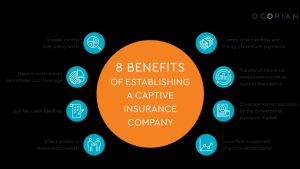
Unlocking the Power of Microcaptives: Maximizing Benefits and Minimizing Risks
Microcaptives are a powerful tool that businesses can utilize to not only manage their risks effectively but also potentially unlock significant tax benefits. These unique insurance arrangements, also known as captive insurance companies, have gained popularity in recent years, particularly under the IRS tax code 831(b). By forming a microcaptive, businesses can self-insure certain risks, retaining more control over their coverage and potentially reducing their overall insurance costs. However, understanding the intricacies of microcaptives and navigating the complexities of the tax code is crucial to maximize the benefits while minimizing potential risks. In this article, we will delve into the world of microcaptives, exploring their advantages, risks, and providing valuable insights on how businesses can make the most of this innovative insurance solution. So, let’s unlock the incredible power of microcaptives and explore the possibilities they offer for businesses of all sizes.
Understanding Microcaptives

A microcaptive is a type of captive insurance company that is formed under section 831(b) of the IRS tax code. Captive insurance involves creating a subsidiary company to handle the insurance needs of the parent company or related companies. This allows the parent company to have more control over their insurance coverage and potentially reduce costs.
The concept of a microcaptive specifically refers to captives that fall under the provisions of section 831(b) of the tax code. This section allows small insurance companies to qualify for special tax treatment, particularly when it comes to their premium income. Under this provision, microcaptives can receive up to $2.3 million in premium income annually without being subject to federal income tax on that income.
The IRS has specific requirements that a microcaptive must meet in order to qualify for these tax benefits. Some of these requirements include having a certain level of risk transfer, maintaining adequate capitalization, and being a bona fide insurance company. Failure to meet these requirements can result in the loss of the tax benefits and potential penalties.
By understanding the basics of microcaptives and the IRS 831(b) tax code, businesses can explore the potential benefits and risks associated with establishing their own captive insurance company. This can provide greater control over insurance coverage, potential tax advantages, and the opportunity to optimize risk management strategies. However, it is crucial to consult with experienced professionals to ensure compliance with tax regulations and maximize the potential benefits of a microcaptive arrangement.
Maximizing Benefits through Microcaptives
Microcaptives, also known as 831(b) captives, offer a unique opportunity for businesses to unlock significant benefits while minimizing risks. By leveraging the IRS 831(b) tax code, companies can establish their own captive insurance company to cover certain risks that traditional insurance may not adequately address. This strategic approach allows businesses to gain more control and flexibility over their insurance coverage, resulting in substantial advantages.
One of the key benefits of microcaptives is the potential for significant cost savings. By forming a captive insurance company, businesses can customize their insurance policies to accurately reflect their specific risks, coverage needs, and risk appetite. This tailored approach often leads to more efficient and cost-effective insurance solutions, as it eliminates the need to pay for unnecessary or inadequate coverage offered by traditional insurers. In turn, businesses can allocate their financial resources more strategically, ultimately increasing their profitability.
In addition to cost savings, microcaptives enable businesses to capture underwriting profits. Unlike traditional insurers, who retain underwriting profits for themselves, companies with captive insurance have the opportunity to directly benefit from the positive underwriting results of their own captive. This means that if the captive experiences favorable claims experience or effective risk management, the business can retain these profits, potentially unlocking a new revenue stream.
Irs 831b Tax Code
Furthermore, microcaptives provide businesses with enhanced risk management capabilities. By establishing their own captive insurance company, businesses have greater control over their insurance program and claims management process. This increased autonomy allows companies to more effectively address unique risks and tailor their risk management strategies accordingly. Additionally, the captive can serve as a valuable tool for implementing proactive risk mitigation measures and enhancing overall risk resilience.
Overall, microcaptives offer a compelling proposition for businesses seeking to optimize their insurance coverage and risk management practices. Through cost savings, potential underwriting profits, and improved risk management capabilities, companies can maximize the benefits derived from microcaptives. However, it is important for businesses to carefully evaluate the feasibility and suitability of establishing a microcaptive within the framework of the IRS 831(b) tax code, considering their specific circumstances and objectives.
Mitigating Risks in Microcaptives
When it comes to microcaptives, it is crucial for businesses to carefully consider the potential risks involved. By taking proactive steps to mitigate these risks, companies can maximize the benefits of their captive insurance arrangements. This section will outline key strategies for minimizing risks within microcaptives.
First and foremost, maintaining compliance with all relevant regulations is essential. Microcaptives, particularly those under the IRS 831(b) tax code, must adhere to strict guidelines to ensure their legitimacy. By diligently following these regulations, businesses can avoid potential legal and financial risks associated with non-compliance.
Another important aspect of risk mitigation in microcaptives is proper risk assessment and management. This involves conducting thorough analyses of the risks faced by the business and developing effective strategies to mitigate them. By identifying and understanding the specific risks involved, companies can implement targeted risk management measures to protect their microcaptive arrangements.
Additionally, regular monitoring and review of the microcaptive’s operations is crucial for risk mitigation. This includes ongoing evaluation of the captive’s financial performance, claims experience, and overall effectiveness. By consistently reviewing the microcaptive’s performance, companies can identify any potential issues or areas of concern early on and take proactive measures to address them.
In conclusion, mitigating risks in microcaptives is vital to ensure the success and longevity of these captive insurance arrangements. By prioritizing compliance, conducting comprehensive risk assessments, and implementing robust monitoring and review processes, businesses can minimize risks and unlock the full power and benefits of microcaptives.

